Retaining walls and shabby fences can affect the curb appeal of your home and be an unsightly eyesore in gardens too. But happily, there are many natural ways to improve the look of garden fences and walls, and one of the best solutions is to cover walls with climbing or trailing plants. In this guide, you’ll discover the best trailing plants to disguise retaining walls and fences, and we’ll also provide some suggestions on how to get the most value out of these striking specimen plants.
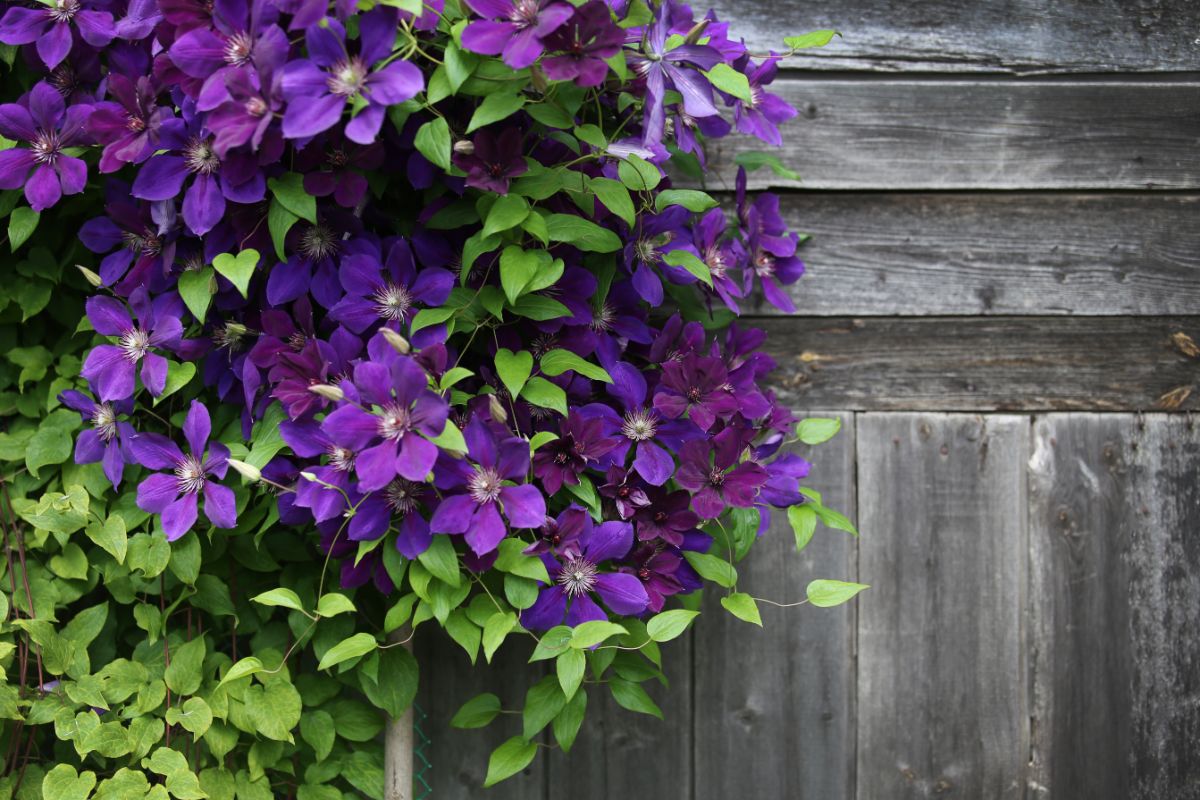
Jump to:
- 25 best trailing plants to disguise walls and fences
- 1. Crossvine (Bignonia capreolata)
- 2. Star jasmine (Trachelospermum jasminoides)
- 3. Climbing hydrangea (Hydrangea petiolaris)
- 4. Coral honeysuckle (Lonicera sempervirens)
- 5. Hops (Humulus lupulus)
- 6. Creeping thyme (Thymus serpyllum)
- 7. Creeping rosemary (Rosmarinus officinalis prostratus)
- 8. American wisteria (Wisteria frutescens)
- 9. Chocolate vine (Akebia quinata)
- 10. Scarlet runner beans (Phaseolus coccineus)
- 11. Nasturtium (Tropaeolum majus)
- 12. Clematis (Clematis spp.)
- 13. Moonflower (Ipomoea alba)
- 14. Wave petunia (Petunia x hybrida)
- 15. Ivy leaf geranium (Pelargonium peltatum)
- 16. Silver falls dichondra (Dichondra argentea)
- 17. Creeping Jenny (Lysimachia nummularia)
- 18. Dutchman’s pipe (Aristolochia macrophylla)
- 19. Boston ivy (Parthenocissus tricuspidata)
- 20. Climbing roses (Rosa spp.)
- 21. Morning glory (Ipomoea purpurea)
- 22. Virginia creeper (Parthenocissus quinquefolia)
- 23. Carolina jessamine (Gelsemium sempervirens)
- 24. Bougainvillea (Bougainvillea spp.)
- 25. Creeping juniper (Juniperus horizontalis)
- Summary
25 best trailing plants to disguise walls and fences

Some trailing plants like English ivy may have aesthetic appeal, but they can grow overly vigorously in gardens, and their strong root systems can sometimes even damage masonry! While gardeners still use these plants in their landscapes, you’ll find the plant selections below are generally easier to maintain than English ivy and other vigorous growers.
1. Crossvine (Bignonia capreolata)

| Plant name: | Crossvine |
| Light requirements: | Full sun to part shade |
| Water requirements: | Moderate to low |
| Growing zone: | Zones 6 to 9 |
| Approximate maximum length: | 30 to 50’ |
Crossvine is native to the United States, and it’s also a top plant to grow if you want to draw hummingbirds to your garden. Crossvine is mostly known for its large, trumpet-shaped flowers, which look a lot like the blooms of trumpet creepers. However, unlike trumpet creepers, crossvines won’t grow invasively.
Crossvine uses sticky pads, known as holdfasts, to clamber over walls, railings, and fences, and they can cling to bricks, wood, or stone. When full-grown, crossvine plants can stretch over 50’ in length, and these plants are evergreen to semi-evergreen in most areas, so they’re ideal for hiding unsightly walls no matter the season!
2. Star jasmine (Trachelospermum jasminoides)
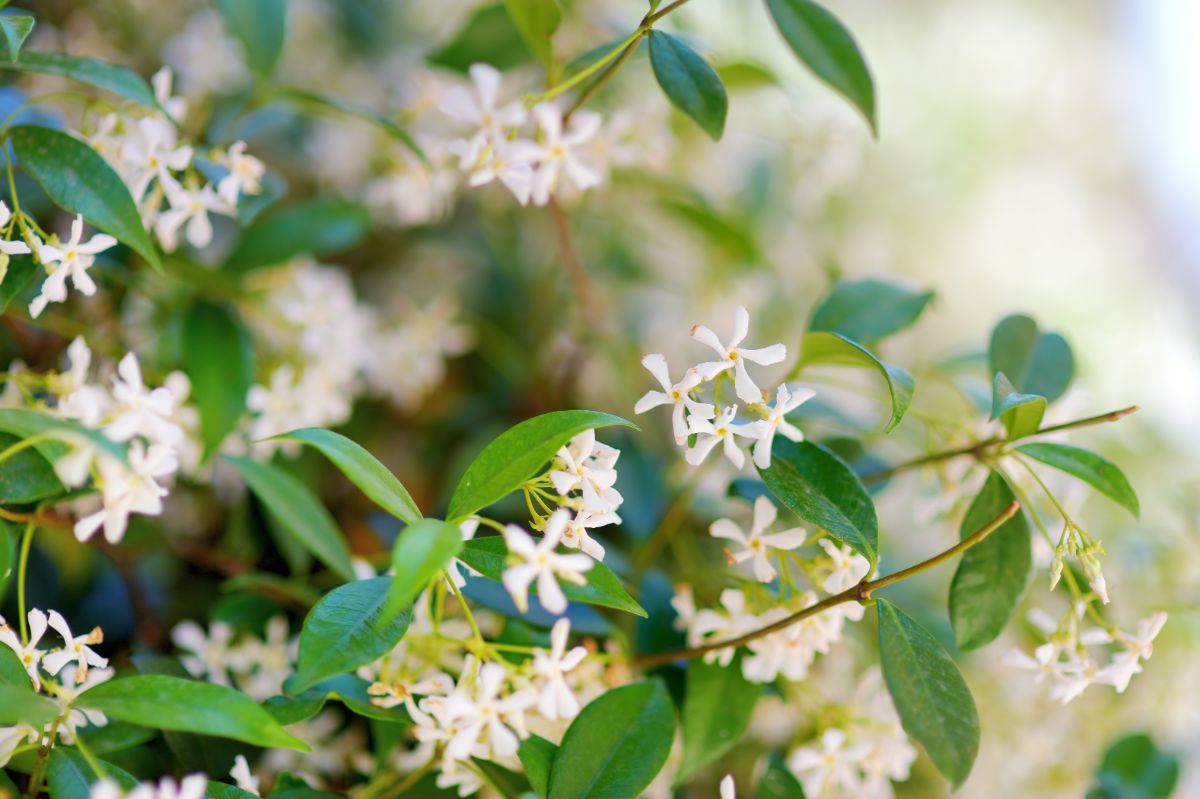
| Plant name: | Star jasmine |
| Light requirements: | Full sun to part shade |
| Water requirements: | High |
| Growing zone: | Zones 8 to 10 |
| Approximate maximum length: | 20 to 30’ |
Like crossvine, star jasmine is another fine choice for pollinator gardens as its creamy, white flowers are highly appealing to bees and butterflies. This climbing plant will also delight garden visitors with its glossy green leaves and sweet fragrance, which feels transportive in a summer garden at night. Despite its name, star jasmine is actually not a true jasmine, and it’s more closely related to oleanders and plumeria.
Full-grown star jasmine plants grow between 20 and 30’ in length; however, these plants are heat lovers, and they only grow in zones 8 through 10.
3. Climbing hydrangea (Hydrangea petiolaris)

| Plant name: | Climbing hydrangea |
| Light requirements: | Full sun to part shade |
| Water requirements: | High to moderate |
| Growing zone: | Zones 5 to 7 |
| Approximate maximum length: | 30 to 50’ |
One of my personal favorite climbing plants, climbing hydrangeas, is a cottage garden must-have, but they will work well in most landscapes. These easy-going climbers can trail over bricks, wood, and stones with ease, and they will light up your garden with large, white blooms that last for months. Climbing hydrangea flowers are typically fragrant, and their flat shape makes them easy landing pads for even large butterflies and other pollinators too.
When mature, climbing hydrangeas can stretch between 30 and 50’ long, but their delicate roots won’t damage masonry. You can also enjoy these plants in fall when their leaves turn a brilliant golden-yellow color.
4. Coral honeysuckle (Lonicera sempervirens)
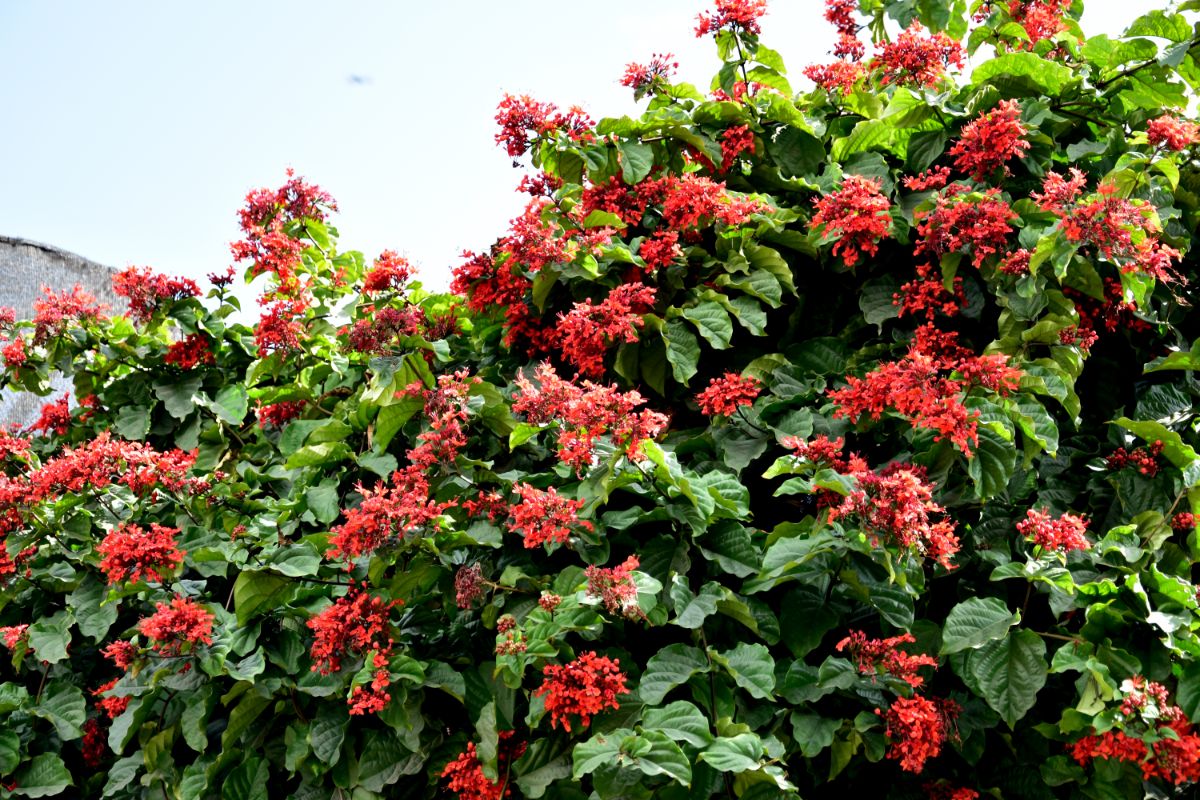
| Plant name: | Coral honeysuckle |
| Light requirements: | Full sun to part shade |
| Water requirements: | Moderate to low |
| Growing zone: | Zones 4 to 11 |
| Approximate maximum length: | 15 to 25’ |
Coral honeysuckle is another hummingbird favorite, but unlike invasive type honeysuckles, coral honeysuckle is native to the United States, and it won’t grow overly vigorously in gardens. This flowering plant doesn’t emit a fragrance, but its bright, coral-toned blooms are certain to draw the eye and add tropical flair to garden walls and fencing. Full-grown plants grow about 15 to 25’ long and, despite their showy appearance, they are surprisingly cold hardy, and they can thrive in areas as cool as zone 4.
5. Hops (Humulus lupulus)
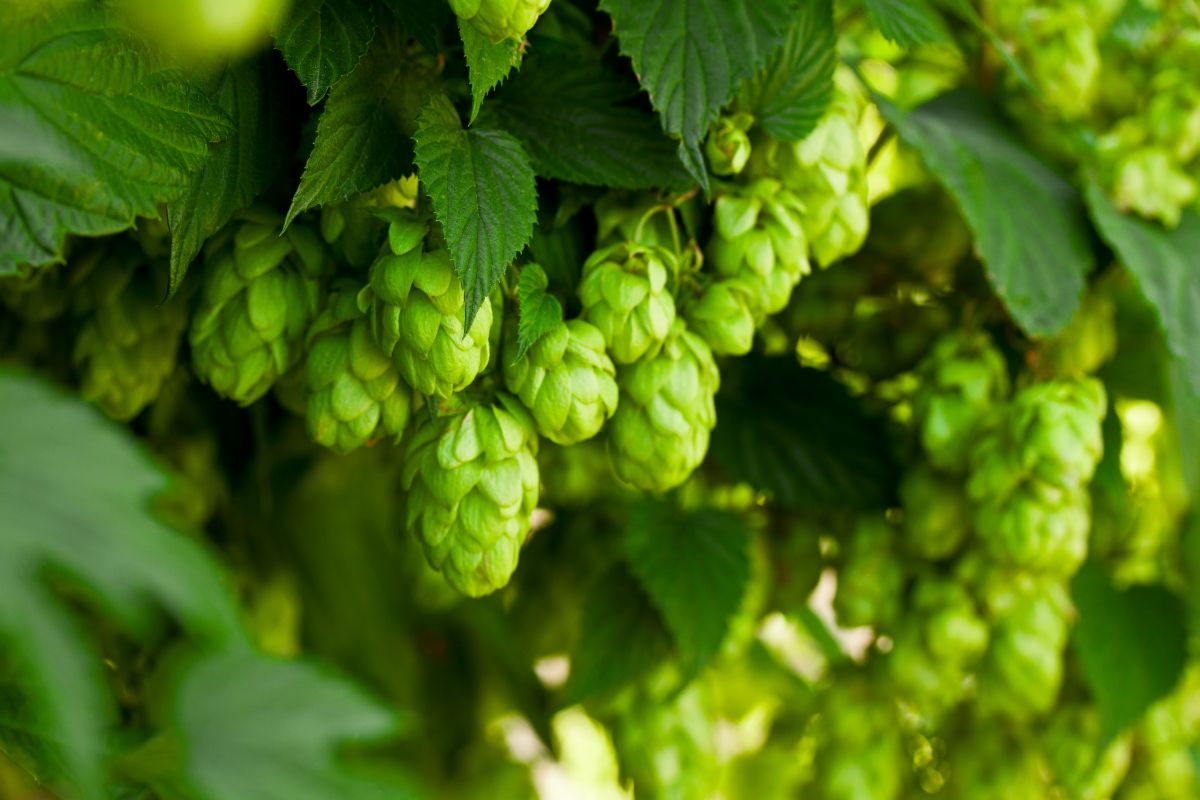
| Plant name: | Hops |
| Light requirements: | Full sun |
| Water requirements: | Moderate |
| Growing zone: | Zones 5 to 8 |
| Approximate maximum length: | 15 to 20’ |
Hops are fun plants to grow in vegetable gardens, but they also have a lot of ornamental appeal, and their adaptable nature makes them top choices for growing over walls and fencing. Hops are technically edible plants, and their pinecone-shaped flowers are used to create IPA beer, but they can also be brewed into a non-alcoholic, sleepy-time tea. Most often, you’ll find hops for sale as root starts, but these plants can quickly grow to over 20 to 30’ in length.
Cold hardy, and resilient, hops are interesting plants to keep, and they’re a top pick if you want to add more edible crops to your foodscape.
6. Creeping thyme (Thymus serpyllum)
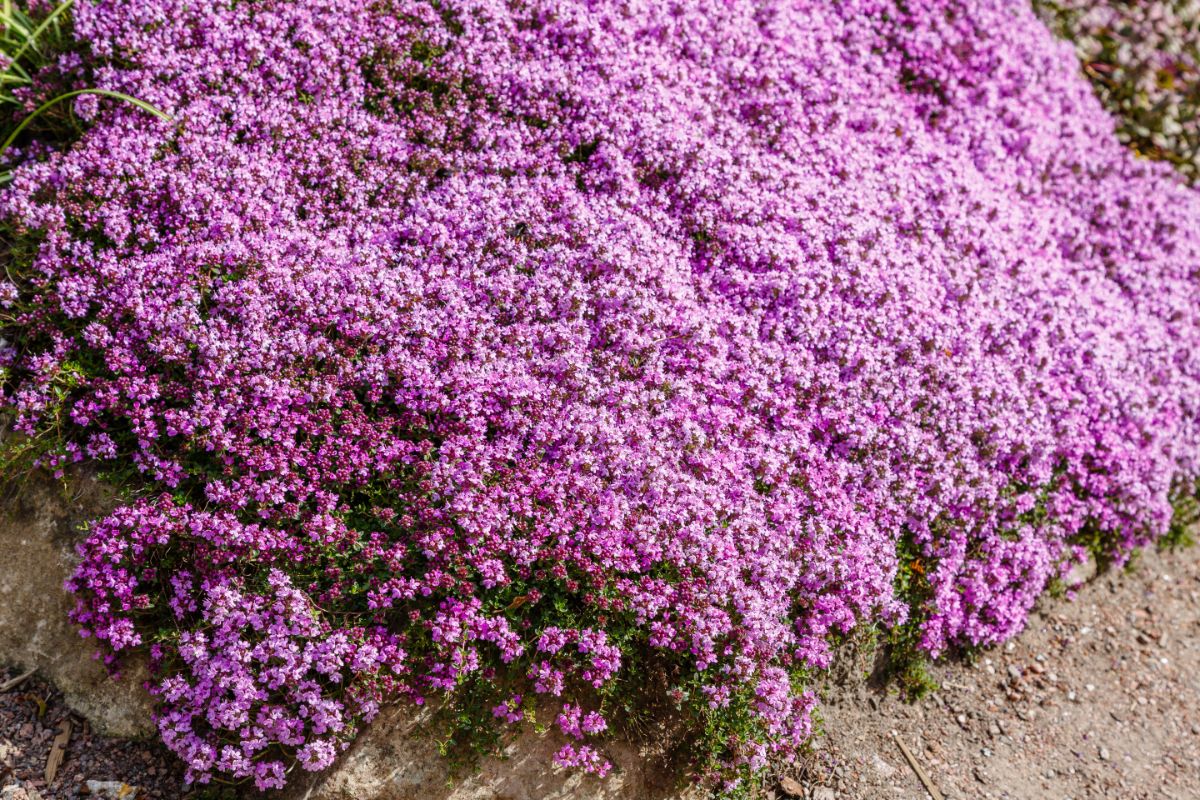
| Plant name: | Creeping thyme |
| Light requirements: | Full sun to part shade |
| Water requirements: | Moderate to low |
| Growing zone: | Zones 5 to 10 |
| Approximate maximum length: | 12” |
Creeping thyme is usually used as a groundcover, but if you plant it near the edge of a retaining wall, this trailing plant can soften the lines of hardscapes and add extra color too. Beyond being edible, creeping thyme is highly ornamental, and it blushes a bright pink color when it blooms in summer to early fall. When crushed underfoot, creeping thyme also exudes a delicious scent, and it has relatively low watering needs, so you won’t need to worry much about maintaining it.
7. Creeping rosemary (Rosmarinus officinalis prostratus)
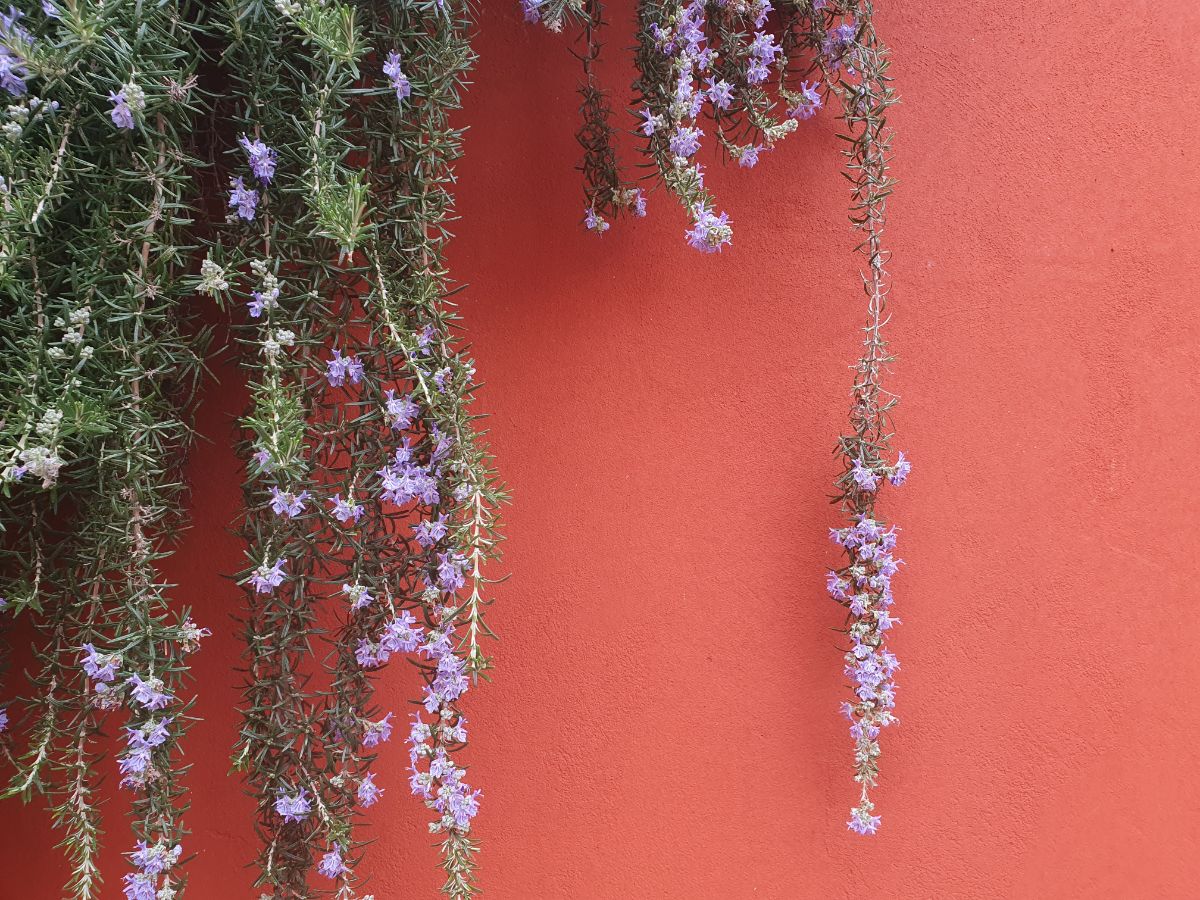
| Plant name: | Creeping rosemary |
| Light requirements: | Full sun |
| Water requirements: | Low |
| Growing zone: | Zones 7 to 11 |
| Approximate maximum length: | 4 to 6’ |
Creeping rosemary is technically the same plant as edible rosemary, and this groundcover is also edible. However, creeping rosemary has a much lower growth habit than standard rosemary, and it looks stunning when allowed to spill over the top of garden walls. Like standard rosemary, creeping rosemary blooms darling, purplish-blue flowers that are highly attractive to pollinators, and it has a rich, herbal fragrance that can dazzle garden visitors too.
One thing to keep in mind with creeping rosemary is that this plant is not particularly cold hardy. While creeping rosemary will grow perennially in zones 7 to 11, it will not survive winters in colder locations.
8. American wisteria (Wisteria frutescens)

| Plant name: | American wisteria |
| Light requirements: | Full sun to part shade |
| Water requirements: | Moderate to low |
| Growing zone: | Zones 5 to 9 |
| Approximate maximum length: | 15 to 30’ |
Not to be confused with the invasive Chinese wisteria, American wisteria is native to the United States, and while it grows vigorously, it is much less inclined towards invasiveness. Often trained to grow over arbors, American wisteria can also make a big impact when grown over fences and garden walls. With sturdy, woody vines, this plant is built to last, and it has those quintessential purple blooms we expected from wisteria species.
9. Chocolate vine (Akebia quinata)
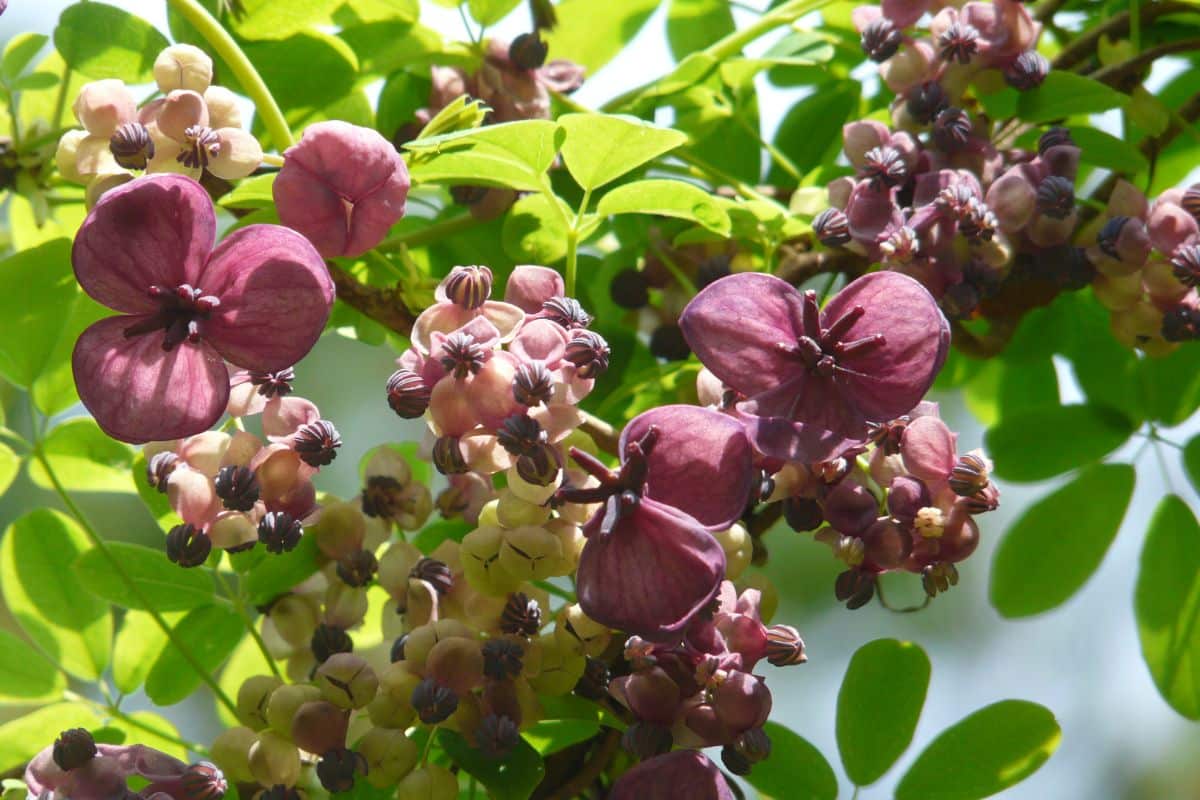
| Plant name: | Chocolate vine |
| Light requirements: | Full sun to shade |
| Water requirements: | Moderate |
| Growing zone: | Zones 4 to 9 |
| Approximate maximum length: | 20 to 40’ |
Chocolate vine is a less commonly grown perennial plant, but it has a lot to recommend it. This attractive climber can stretch 30’ long, and it produces purplish-brown flowers that emit a sweet, chocolate-like fragrance that may awaken your chocolate cravings! After flowering, chocolate vine sometimes produces eggplant-shaped fruit, which are edible but not very tasty.
Despite its tropical look, chocolate vine can grow in cooler climates, and it’s actually native to Asia and parts of America. Plus, this plant grows quickly, so if you want to conceal your garden wall fast, chocolate vine may be a good plant to try!
10. Scarlet runner beans (Phaseolus coccineus)
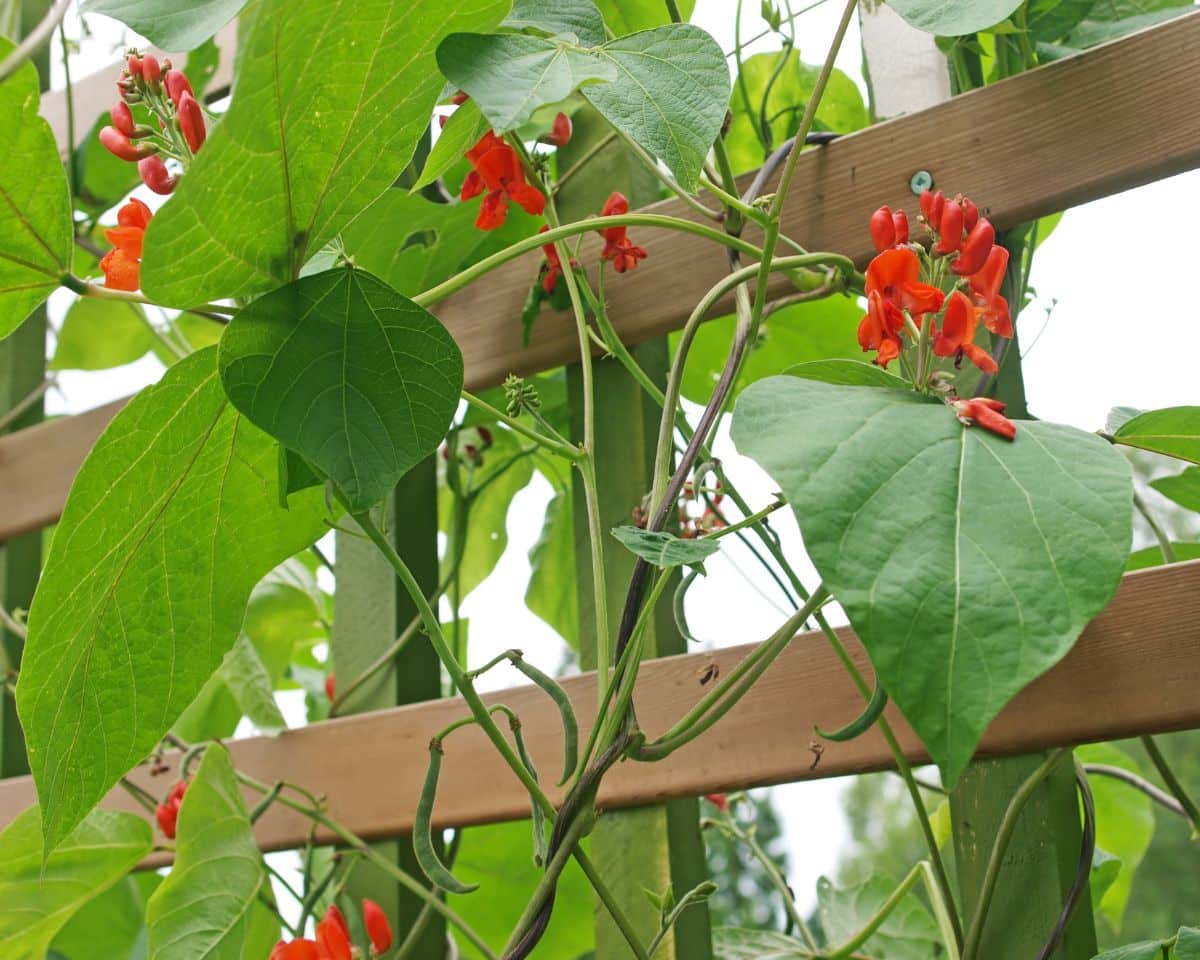
| Plant name: | Scarlet runner beans |
| Light requirements: | Full sun |
| Water requirements: | Moderate |
| Growing zone: | Zones 7 to 11 |
| Approximate maximum length: | 15’ |
Scarlet runner beans are edible plants that can be grown in vegetable gardens and harvested for their tasty beans. But scarlet runner beans are mostly known for their showy, crimson flowers that bloom throughout summer and early fall and make this plant a fine pick for ornamental gardens. Like other bean plants, scarlet runner beans are mostly grown as annuals, and they’ll need to be planted every year in cool areas, but they do grow quickly, and they can grow up to 20’ in a single season!
11. Nasturtium (Tropaeolum majus)

| Plant name: | Nasturtium |
| Light requirements: | Full sun to part shade |
| Water requirements: | Moderate |
| Growing zone: | Zones 9 to 11 |
| Approximate maximum length: | 1 to 10’ |
Another edible option, nasturtiums, are well known for their bright orange or yellow flowers and their peppery leaves. But trailing-type nasturtiums look very pretty in ornamental gardens, and their cascading growth habits make them top plants to grow if you want to conceal retaining walls and other low structures in your garden. Nasturtium plants are usually grown as annuals, but they’re fast-growing, and they continue to bloom for many months, providing lots of much-needed garden color.
12. Clematis (Clematis spp.)
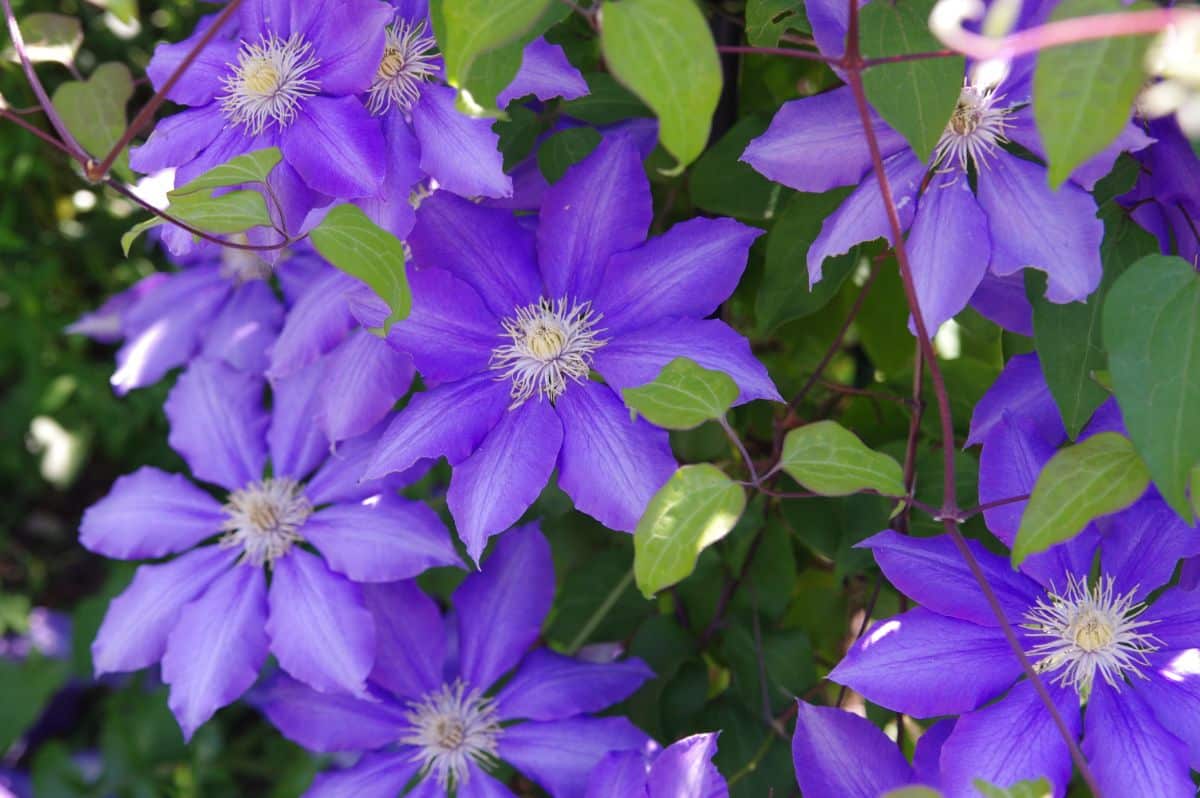
| Plant name: | Clematis |
| Light requirements: | Full sun to part shade |
| Water requirements: | Moderate |
| Growing zone: | Zones 4 to 9 |
| Approximate maximum length: | 8 to 30’, depending on a variety |
Sometimes known as the “queen of the vines,” clematis is likely to be the star of the garden whenever it’s in bloom. Clematis flowers range in shade from purple and red to pink and white, and flowers can measure up to 10” across! These plants are also long-lived, and they’ll come back year after year, even in cooler growing regions.
Most clematis plants have woody vines that can wend and trail their way over unsightly fences and railings. After flowering, clematis blooms turn into fluffy seed pods that will add interesting texture to your garden late in the season.
13. Moonflower (Ipomoea alba)

| Plant name: | Moonflower |
| Light requirements: | Full sun |
| Water requirements: | Moderate |
| Growing zone: | Zones 3 to 9 |
| Approximate maximum length: | 10 to 15’ |
Moonflower is a close relative of morning glories; however, unlike their flowering cousin, moonflowers mostly bloom at night. With bright, white flowers that show well after dark, moonflowers are a unique choice for garden beds, and they’re a must-have if you want to attract nocturnal pollinators, like moths, to your garden. Like morning glories, moonflowers are easy to grow from seed, and they’ll clamber quickly over metal, wood, and brick garden walls.
14. Wave petunia (Petunia x hybrida)
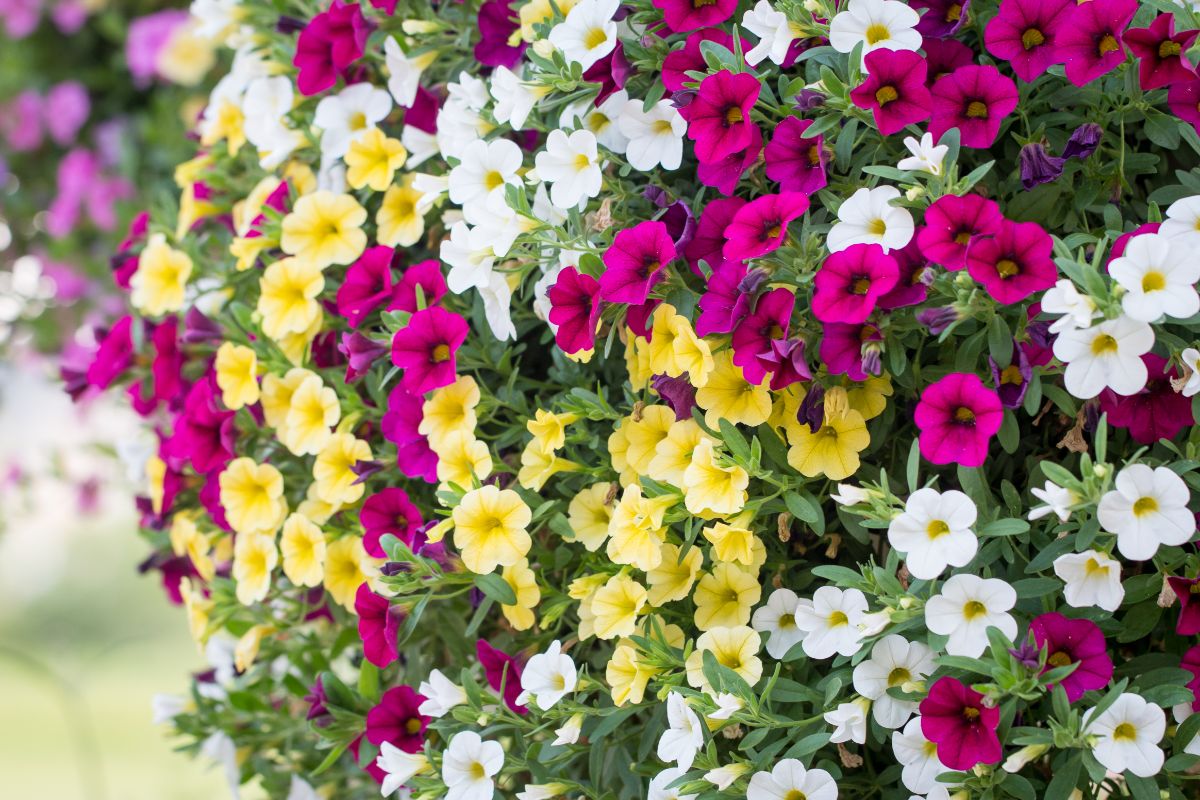
| Plant name: | Wave petunia |
| Light requirements: | Full sun |
| Water requirements: | Moderate |
| Growing zone: | Zones 10 to 11 |
| Approximate maximum length: | 2 to 4’ |
Unlike standard petunias, wave petunias were bred for their cold resistance and their trailing growth habit. Often, you’ll find wave petunias growing in hanging baskets under sunny front porches, but these plants can also be used to conceal unsightly garden walls. Wave petunias grow best in lots of sun, and while they need frequent watering, they’re otherwise undemanding, and they’ll charm you with their prolific and colorful flowers.
15. Ivy leaf geranium (Pelargonium peltatum)
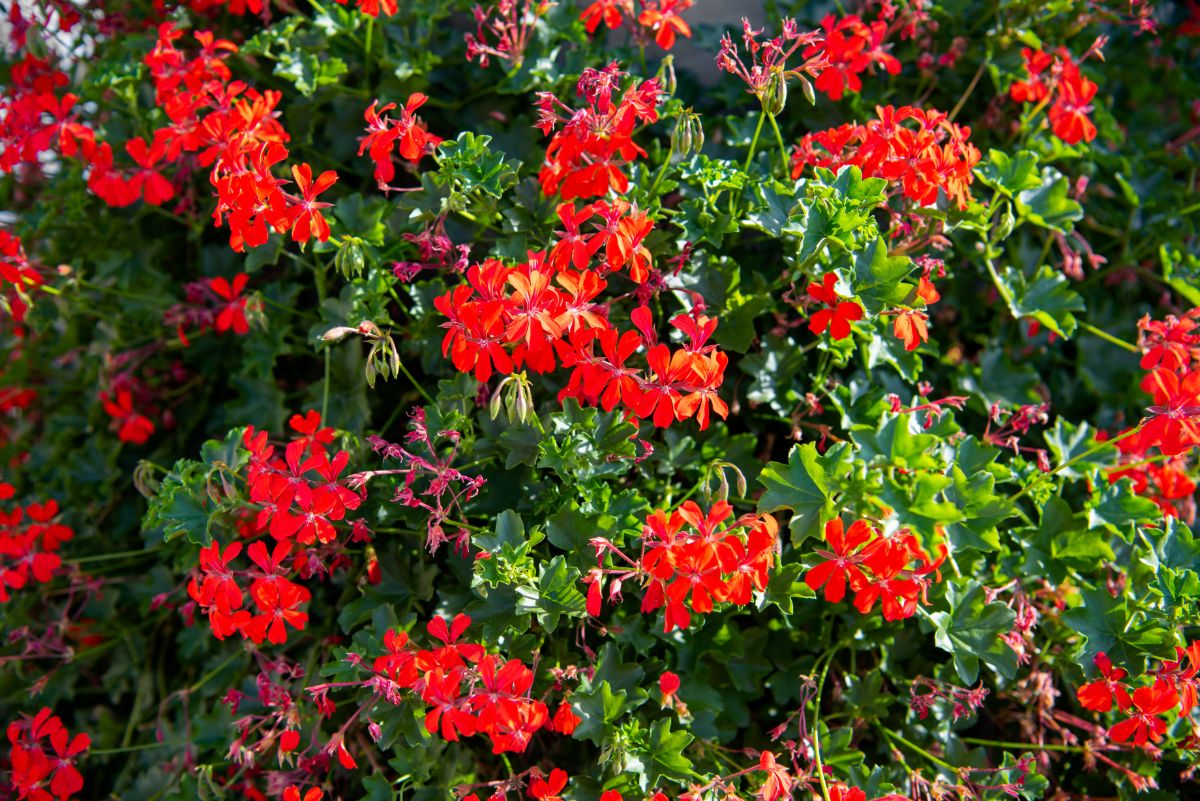
| Plant name: | Ivy leaf geranium |
| Light requirements: | Full sun to part shade |
| Water requirements: | Moderate |
| Growing zone: | Zones 10 to 11 |
| Approximate maximum length: | 3 to 5’ |
Ivy leaf geraniums are actually not true geraniums, and they belong to the Pelargonium family, which is native to South Africa. These trailing plants are often used in hanging baskets, but they can hold their own in larger, inground beds, and their long stems will drape gracefully over garden walls. When mature, ivy leaf geraniums can spread over 5’ feet, and their flowers come in shades of purple, pink, red, and white.
16. Silver falls dichondra (Dichondra argentea)
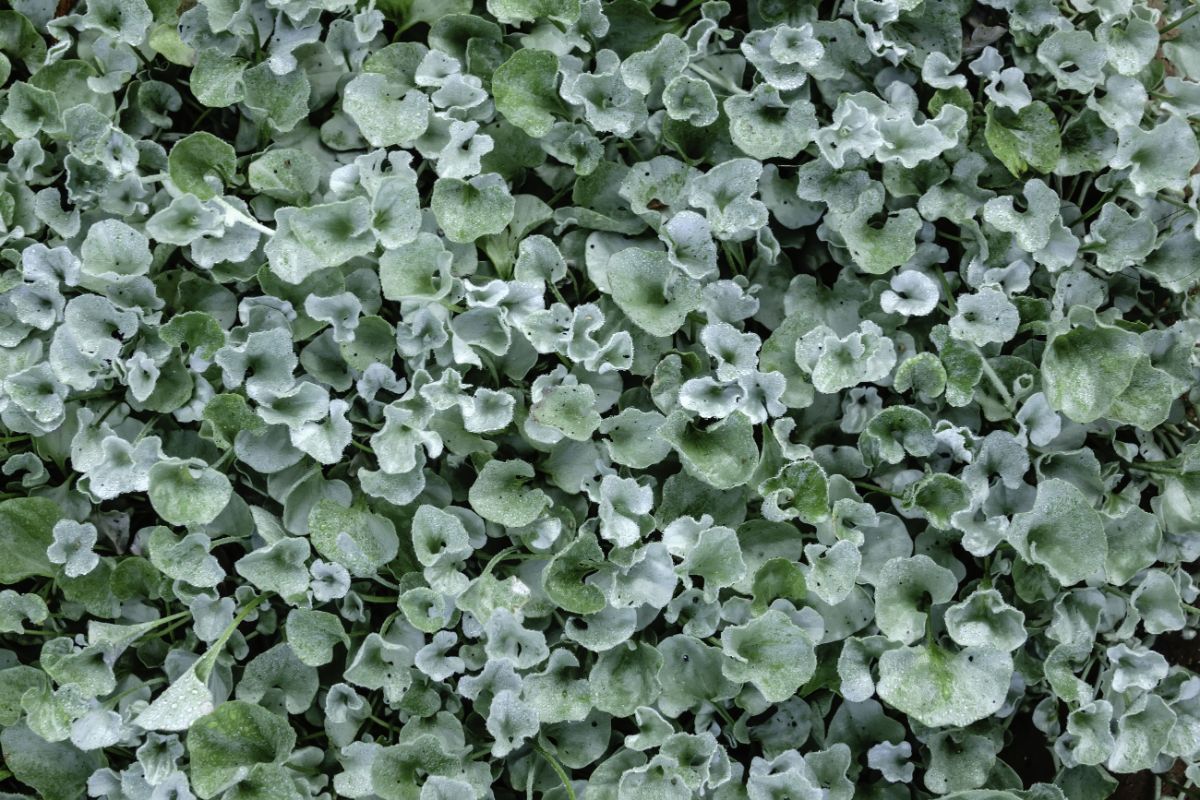
| Plant name: | Silver falls dichondra |
| Light requirements: | Full sun to part shade |
| Water requirements: | Moderate to low |
| Growing zone: | Zones 8 to 10 |
| Approximate maximum length: | 3 to 4’ |
Also known as the silver nickel vine, silver falls dichondra is mostly grown as an annual, although it can grow perennially in zones 10 through 12. With striking, silver-toned leaves, silver falls dichondra will add something different to garden walls, and it looks particularly pretty when planted en masse or when grown with plants with contrasting foliage colors. In warm areas, silver falls dichondra spreads rapidly, and it can sometimes become invasive, so you’ll want to use caution when growing this plant in tropical zones.
17. Creeping Jenny (Lysimachia nummularia)

| Plant name: | Creeping Jenny |
| Light requirements: | Full sun to part shade |
| Water requirements: | High |
| Growing zone: | Zones 4 to 9 |
| Approximate maximum length: | 12 to 18” |
Creeping Jenny is a favorite among container growers, but its spreading stems also make it an exceptional ground cover and wall covering. While creeping Jenny does flower, the yellow blooms are rather inconspicuous, and they don’t last very long. Most often, growers keep creeping Jenny for its bright, chartreuse green leaves, which can’t help but liven up even the drabbest garden corner.
Unlike some of the other plants on this list, creeping Jenny does have relatively high water needs, so you may not want to grow it in very dry areas. If you do decide to keep creeping Jenny, make sure you water your plant often to keep it looking its best!
18. Dutchman’s pipe (Aristolochia macrophylla)

| Plant name: | Dutchman’s pipe |
| Light requirements: | Full sun to part shade |
| Water requirements: | High |
| Growing zone: | Zones 4 to 8 |
| Approximate maximum length: | 15 to 30’ |
Native to North America, Dutchman’s pipe is an intriguing plant with uniquely shaped blooms that look a bit like an antique pipe. This plant also produces large, heart-shaped leaves that are ideal for casting shade in bright gardens, but they can also be used to conceal garden walls and fences and add extra privacy too. A fast grower, mature Dutchman’s pipe plants can grow over 30’ long, and they overwinter well even in areas as chilly as zone 4.
19. Boston ivy (Parthenocissus tricuspidata)
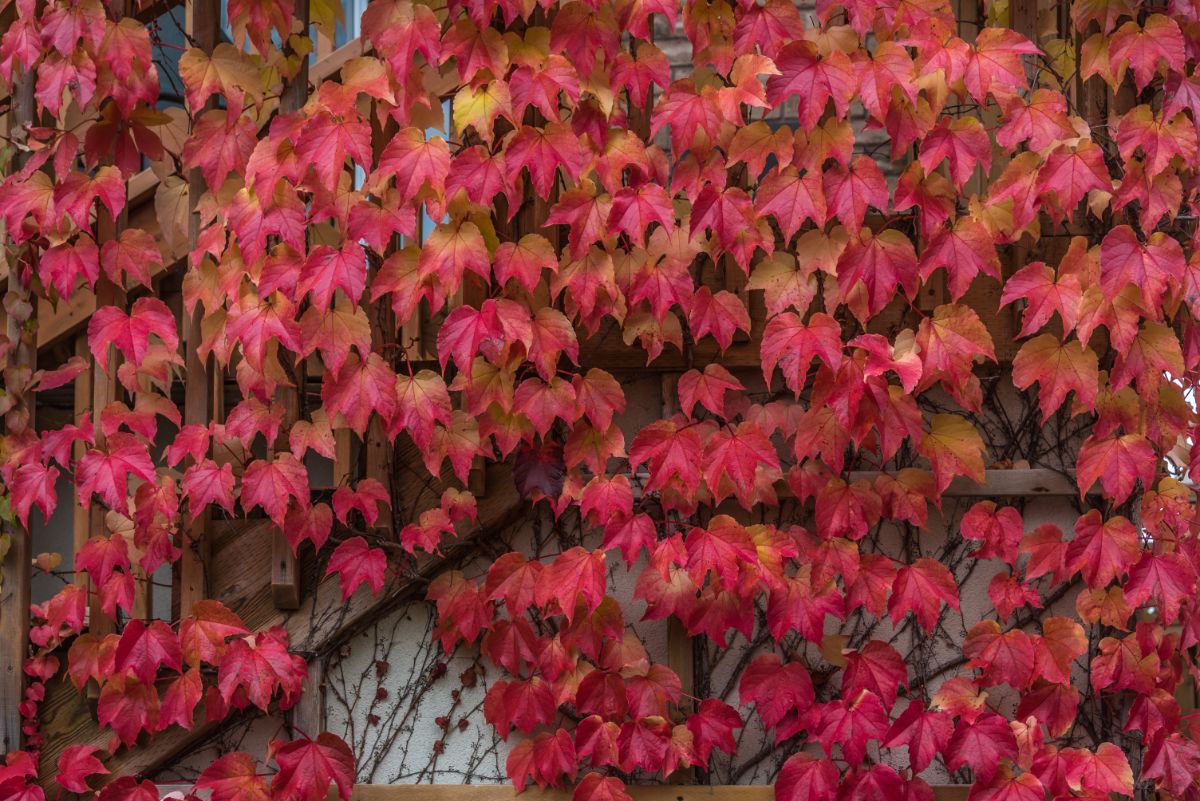
| Plant name: | Boston ivy |
| Light requirements: | Full sun to part shade |
| Water requirements: | Moderate to low |
| Growing zone: | Zones 4 to 8 |
| Approximate maximum length: | 30 to 50’ |
If you love the look of English ivy, but you don’t want to risk damaging your garden walls, Boston ivy is an easygoing substitute that’s less likely to cause issues. While some Boston ivy plants can occasionally damage gutters or wood siding, this is less likely to occur than with English ivy, and Boston ivy plants are even easier to maintain if you prune them often.
While Boston ivy can add privacy to your garden with its rich green leaves, this plant adds interest throughout the changing seasons as well. In fall, Boston ivy leaves develop a deep, crimson color, and this plant also produces small, blue berries that are a favorite among wild birds. Interestingly, Boston ivy is where “ivy” league schools get their name!
20. Climbing roses (Rosa spp.)
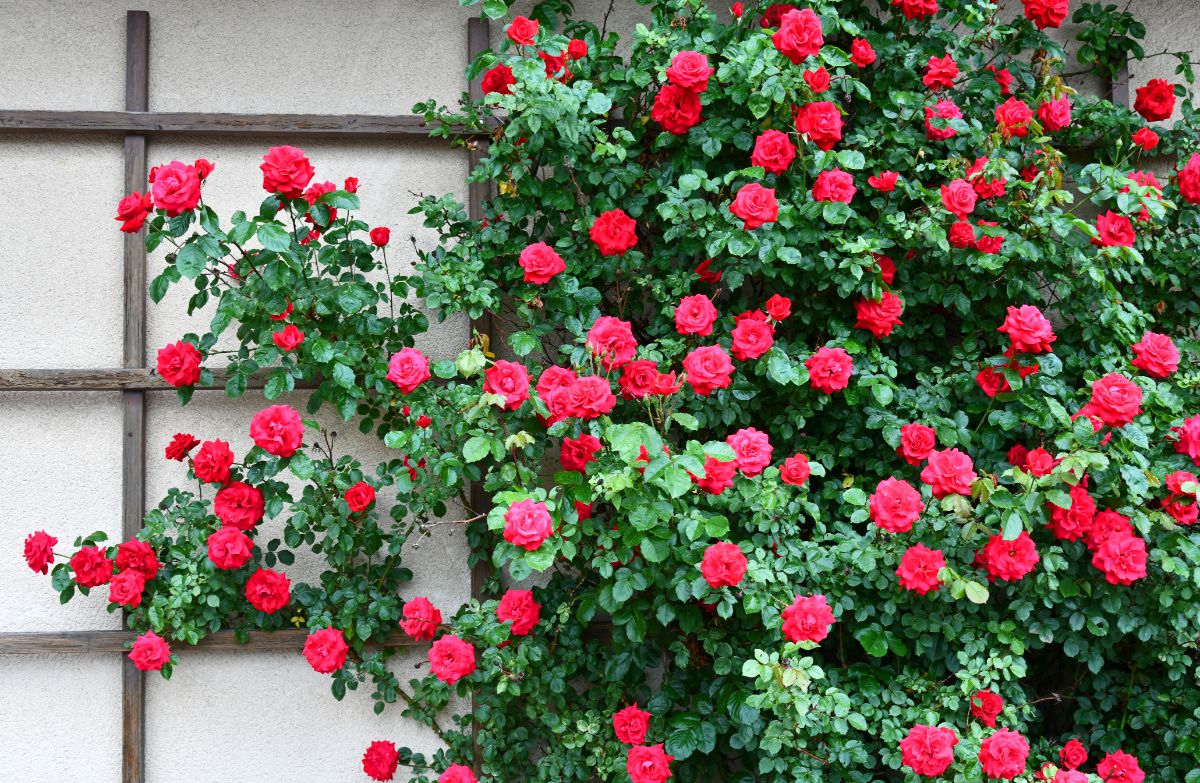
| Plant name: | Climbing roses |
| Light requirements: | Full sun |
| Water requirements: | Moderate |
| Growing zone: | Zones 5 to 9 |
| Approximate maximum length: | 6 to 12’ |
There’s nothing quite as classic as a climbing rose winding its way over fences and pergolas. But if you’re looking for a plant to conceal a concrete wall or an old metal fence, climbing roses can work for that too!
Climbing roses will happily trail over an assortment of structures, but they’re mostly known for their darling flowers that come in an assortment of shades, including pink, white, and red. If you have a cottage garden, climbing roses are a traditional choice, but these crowd favorites will blend in well with most garden designs.
21. Morning glory (Ipomoea purpurea)
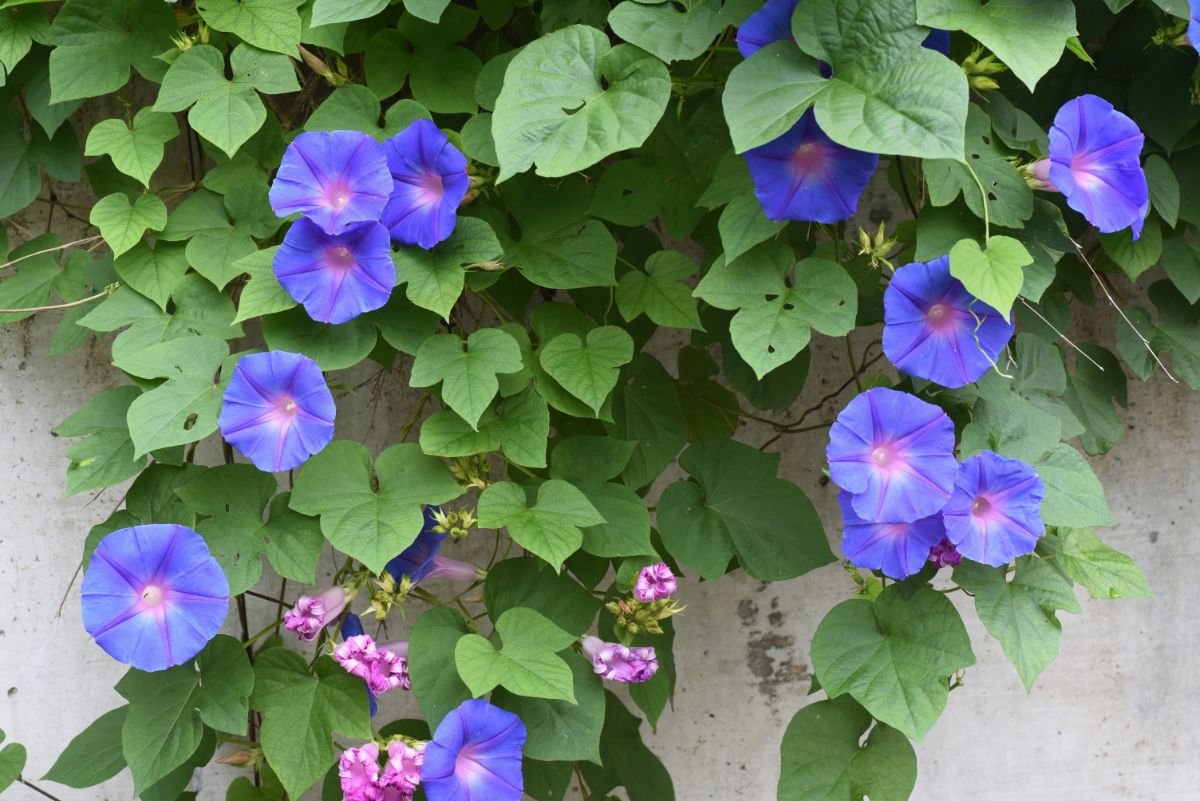
| Plant name: | Morning glory |
| Light requirements: | Full sun |
| Water requirements: | Moderate |
| Growing zone: | Zones 2 to 11 |
| Approximate maximum length: | 6 to 12’ |
Morning glories are another fast-growing vine that can be useful for creating extra privacy and covering up garden walls and fencing too. In most areas, morning glories are grown as annuals, but they can grow perennially in growing zones 9 to 11. Either way, morning glories are very easy to start from seed, but they’ll grow best if you directly sow seeds outdoors after all danger of frost has passed.
Once planted, morning glories are quick to sprout, and they can spread over 8’ in length when mature. The trumpet-shaped flowers of these plants come in almost every color you could want, including blue, purple, and pink. Most morning glory flowers only last one day, and they close up when the sky begins to darken in the evening.
22. Virginia creeper (Parthenocissus quinquefolia)
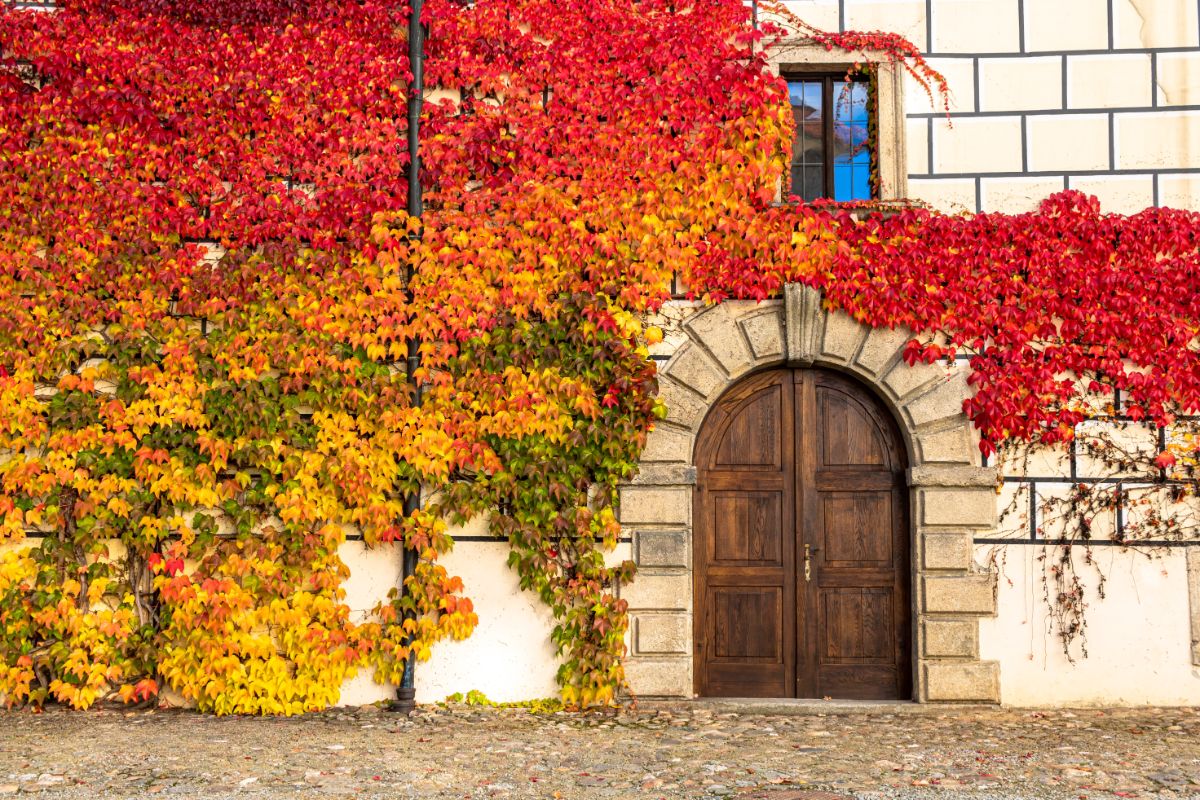
| Plant name: | Virginia creeper |
| Light requirements: | Full sun to shade |
| Water requirements: | Moderate |
| Growing zone: | Zones 3 to 9 |
| Approximate maximum length: | Up to 50’ |
Virginia creeper is often thought of as a nuisance plant, but it is actually a valuable native species that’s an important host plant for sphinx moths and other pollinators. These plants are sometimes kept as groundcovers, but they also spread beautifully across garden walls, and they look particularly pretty on brick. While Virginia creeper does flower in spring, most people grow this plant for its lush, color-changing leaves that turn a bright, fiery red in autumn.
At times, Virigina creeper is confused with poison ivy; however, while poison ivy famously has 3 leaves, Virginia creeper has 5 leaflets. Some people are sensitive to Virginia creeper, and they may develop rashes when handling this plant. So, if you’re unsure how you personally react to Virginia creeper, you may want to wear gloves when touching this vine.
23. Carolina jessamine (Gelsemium sempervirens)
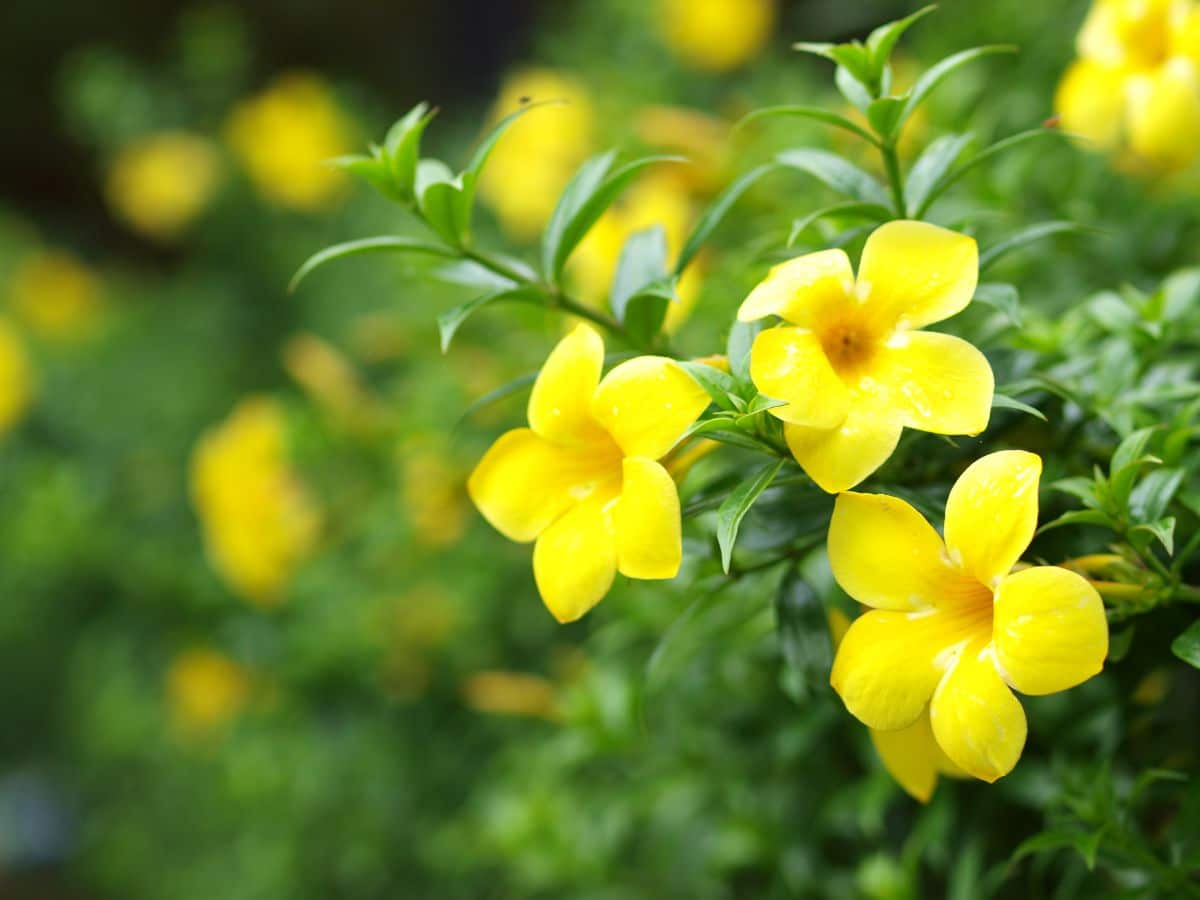
| Plant name: | Carolina jessamine |
| Light requirements: | Full sun to part shade |
| Water requirements: | Moderate to low |
| Growing zone: | Zones 6 to 9 |
| Approximate maximum length: | 20’ |
Another excellent vining plant for warmer climates, Carolina jessamine is hardy in zones 7 to 9, and it’s a vigorous grower that climbs up anything it can wrap its stem around. If you want to encourage jessamine to scramble up brick walls, you can add a bit of wire or other anchoring points to help the plant climb. Once established, Carolina jessamine is certain to delight with its fragrant, sunny yellow flowers and glossy, evergreen leaves.
24. Bougainvillea (Bougainvillea spp.)
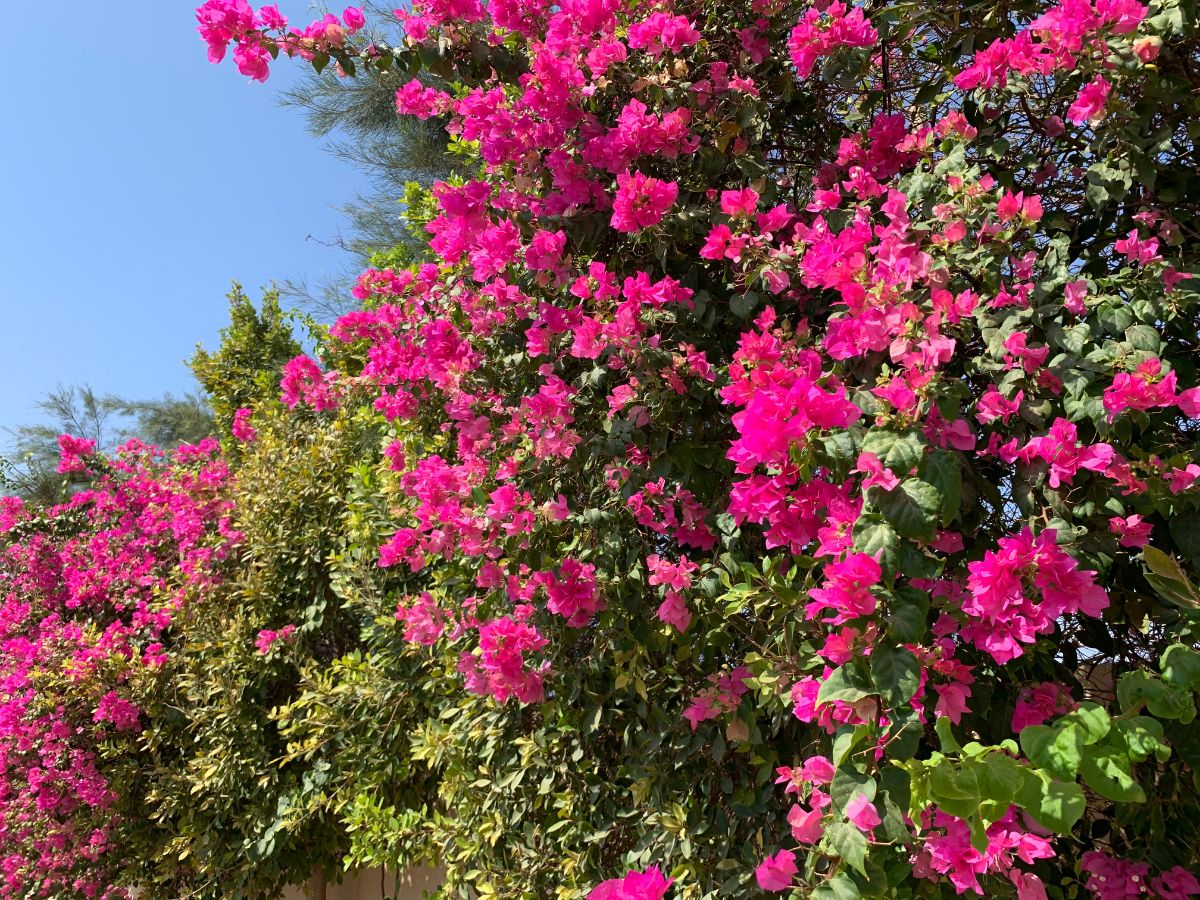
| Plant name: | Bougainvillea |
| Light requirements: | Full sun |
| Water requirements: | Moderate to low |
| Growing zone: | Zones 9 to 11 |
| Approximate maximum length: | 10 to 40’ |
Native to Central and South America, bougainvillea are known for their riot of flashy flowers that can bloom year-round with proper care. These heat-loving plants are only hardy to growing zone 9, but if you live in an area where bougainvillea can survive the winter, these plants are some of the most rewarding vines you can keep. Not only are bougainvillea vines great for hiding eyesores, but they’ll make your garden feel like a private oasis, and they can even be grown as groundcovers for weed suppression.
25. Creeping juniper (Juniperus horizontalis)
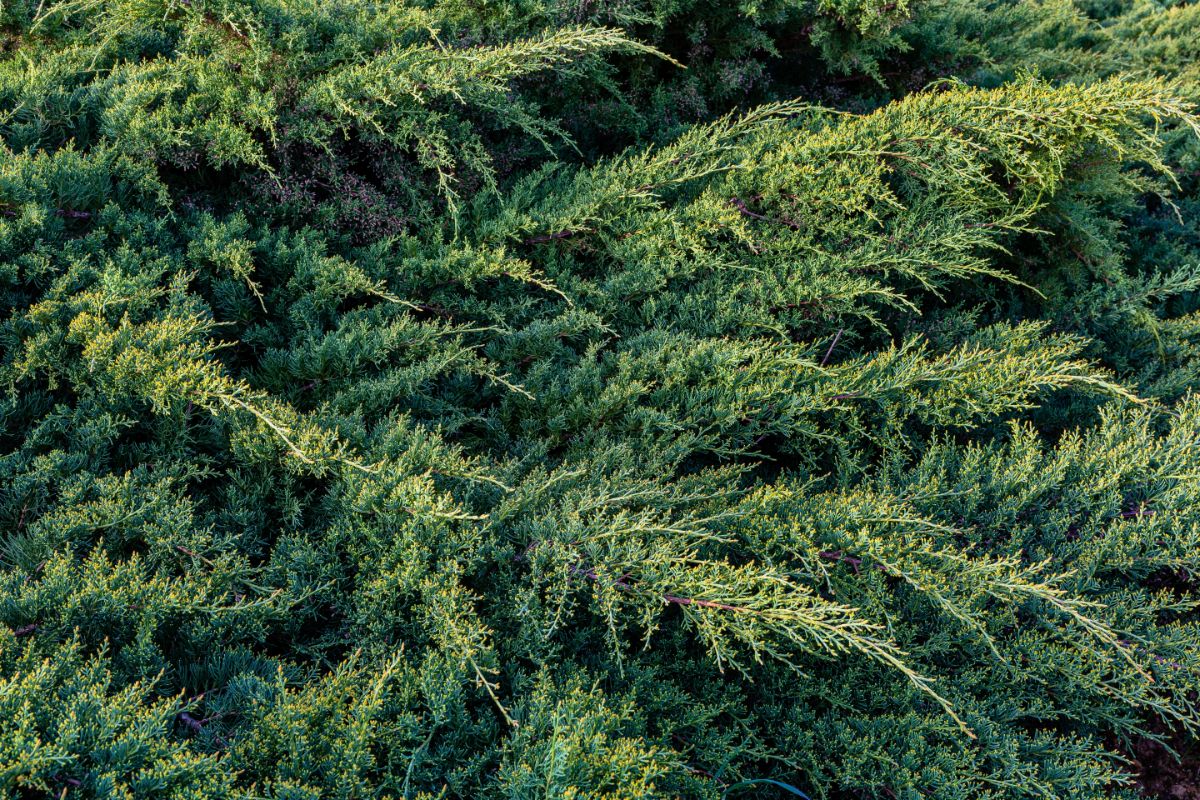
| Plant name: | Creeping juniper |
| Light requirements: | Full sun |
| Water requirements: | Moderate to low |
| Growing zone: | Zones 3 to 9 |
| Approximate maximum length: | Up to 10’ |
A hardy plant that will add texture and elegance to low retaining walls and other short structures, creeping juniper is prized for its bluish-green needles and simple care requirements. As an evergreen plant, creeping juniper can be enjoyed throughout the seasons, and it’s also moderately drought tolerant once established. Plant creeping juniper near the edge of garden walls and watch as the plant stems slowly cascade over and conceal drab concrete, discolored rocks, and old bricks too!
Summary
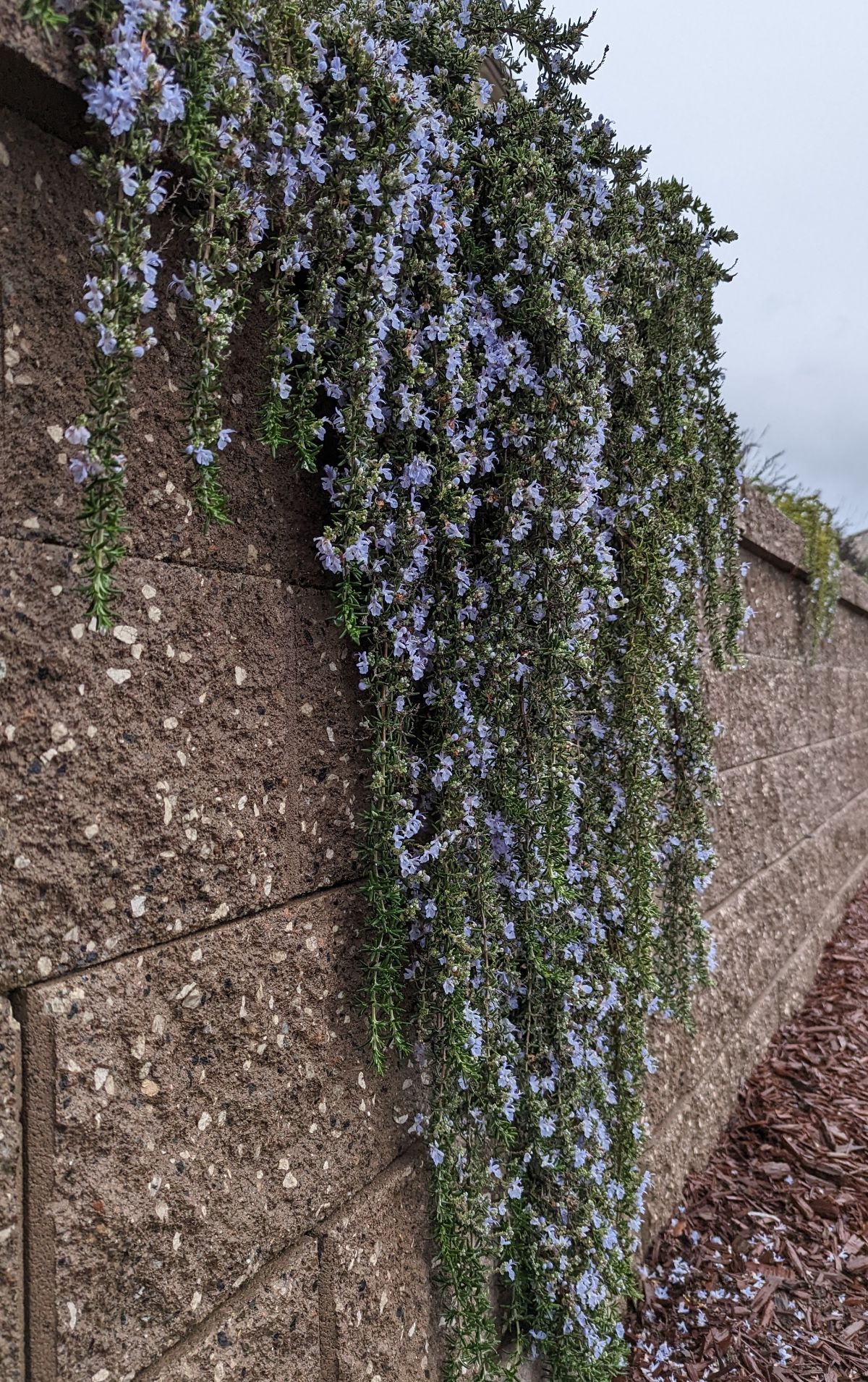
Old garden walls can be drab and unbecoming, and if they affect your home’s curb appeal, they can even cost you money! But the good news is that you can spruce up old fences and shabby retaining walls with a few vining plants with vibrant green leaves and brilliant flower colors. The plants we’ve covered today are ideal for concealing walls and fences of all shapes and sizes, so try a plant or two and watch how they transform even the grimmest outdoor wall into a lush green space!
If you’re looking for even more vining plant suggestions for your garden, check out our guide on the best climbing plants to grow for pollinators right here!

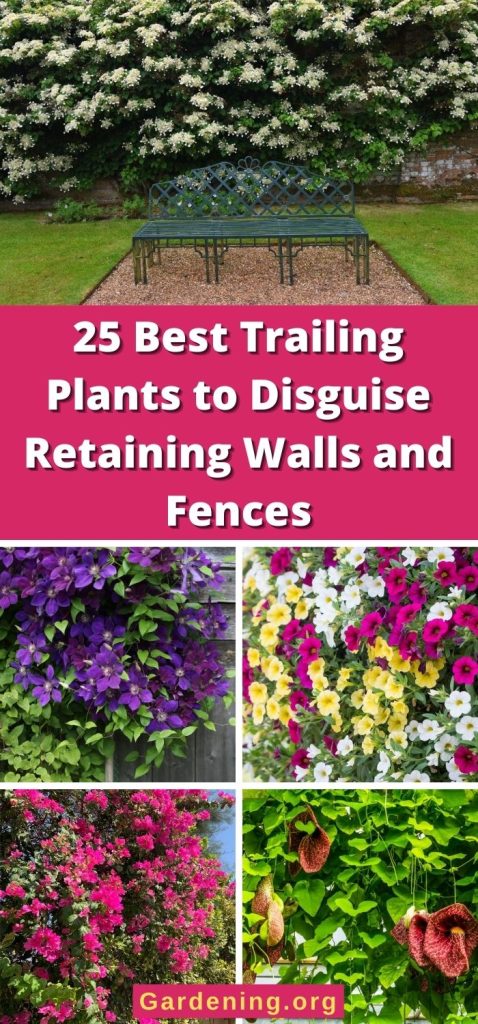
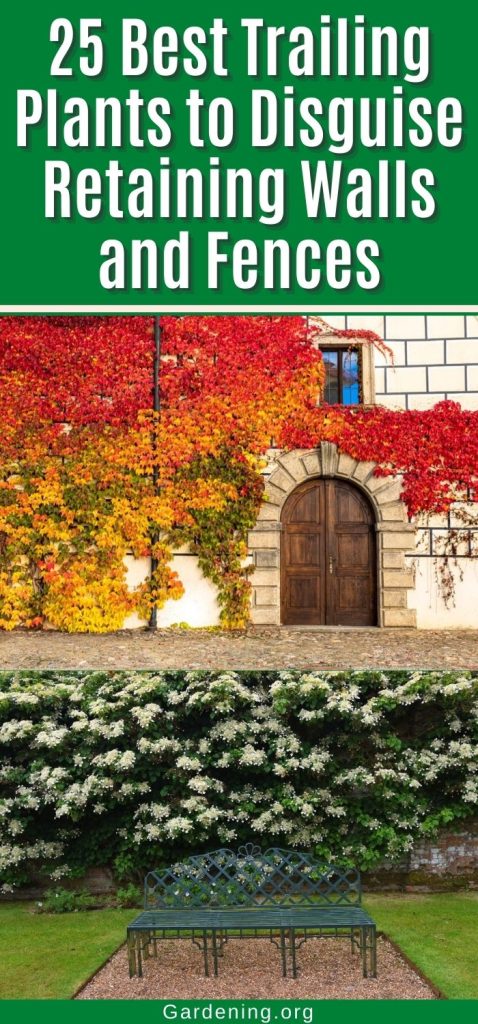
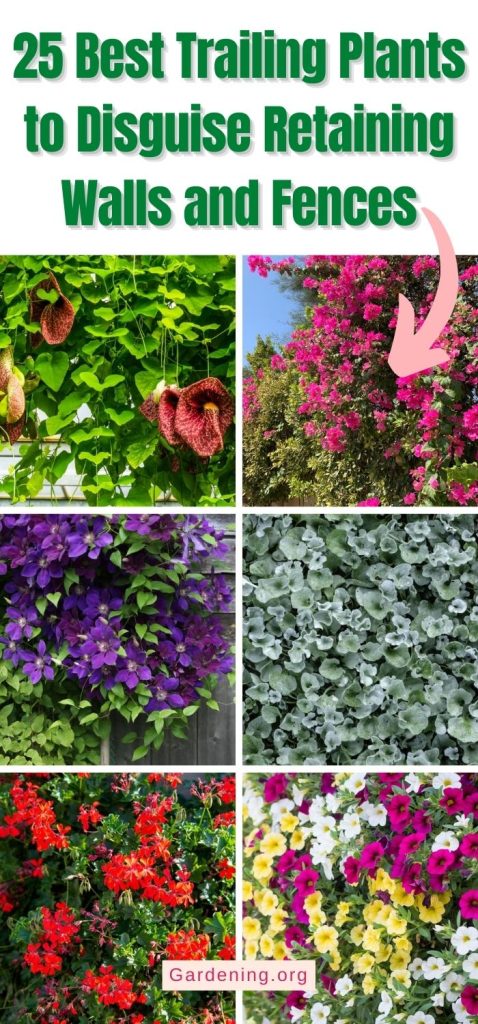


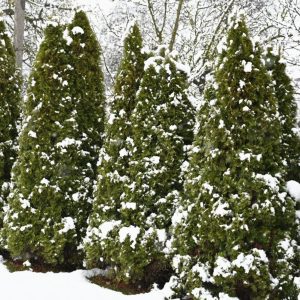


Leave a Reply